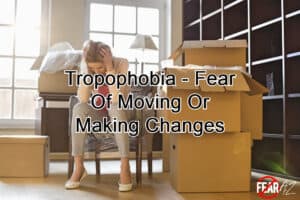Share This Article
Let’s Unpack Tropophobia, or the Fear of Moving
Are you afraid of making changes in your life? Do you love your daily routine, and does even talking about a slight deviation from it shake you to your core?
If yes, you may be suffering from tropophobia, also known as the fear of moving or making changes. It can be difficult to explain your reaction to change. Sometimes you may come off as stubborn or defiant.
However, don’t worry. There are many different kinds of phobias, and thanks to advancements in the medical field and increased awareness, dealing with this phobia is well within your reach.
You can wave your fear goodbye with patience, dedication, and consistency. Or at least learn how best to cope with it.
Keep reading to learn more about the fear of moving, its causes, and treatment.

What Is Tropophobia
Everyone fears change. It’s the factor of the unknown that takes away the predictability of life and instills fear in humans.
Most like to follow a daily routine. The fact that they know what is coming next gives them peace and security. Any divergence can be a source of discomfort and stress. However, this can lead to anxiety for people who have tropophobia.
Tropophobia is the irrational fear of moving or making changes. It is often associated with metathesiophobia, the fear of change. Both fears cause anxiety at the thought of what is to come after the change.
The fear stems from the uncertainty that is to follow. Moving things or making changes means we need to make mental adjustments. These minute changes can push us out of our comfort zone and threaten our security, making us anxious.
Also, at times, the change may be due to uncontrollable situations that further increase anxiety. A person may feel trapped in the situation when the changes are due to factors like a pandemic, recession, or an accident.
Tropophobia does not necessarily mean physical movement or change. It could be a change in personality, attitude, or skills. It could mean moving from one country to another, from one state to another, or just moving to the apartment next door.
Someone with this phobia gets very anxious at the thought of moving anything. The phobia can extend to the point where the person may start experiencing panic attacks.
A person may start avoiding the stimuli to stop the feelings of anxiety and stress. This means they would avoid moving things or making any changes. Although they may not experience any symptoms this way, their phobia remains.
Tropophobia Causes
Fear is a natural and necessary reaction for survival. However, it becomes a phobia when fear repeatedly advances to an extreme level in response to certain, nonthreatening stimuli.
The exact cause of why a regular thing or activity can become a subject of fear is still unknown. However, there are a few theories about why a person may develop specific phobias like tropophobia.
The most important factor in the development of mental illnesses is genetic predisposition. If a person has a family history of any mental illness, especially anxiety disorder, they are at a higher risk of developing a phobia. However, there has to be a stimulus which sets the wheel in motion.
So, even a predisposed person will not develop tropophobia if not triggered. However, even the smallest stimuli, like watching someone else cope with a mental illness, can trigger a predisposed person.
Another common factor that leads to a phobia is experience. If a person had a traumatic experience after making a change, their unconscious mind will correlate change and bad experiences and develop tropophobia.
Tropophobia Symptoms
The most common symptom of specific phobias is anxiety. Apart from anxiety, a person may experience a few or more of the following symptoms depending on the severity of the phobia.
Physical Symptoms
- Sweating
- Hyperventilating
- Irregular heartbeat
- Increase/decrease in blood pressure
- Digestive issues
- Headache
Psychological Symptoms
- Anxiety
- Panic attack
- Dreading something bad will happen
- Fear of losing control
- Fear of dying
Tropophobia Treatment
There is no definitive treatment for tropophobia; however, therapies that work for other specific phobias also work to overcome the fear of moving.
First, seek a proper diagnosis by a medical practitioner. And if it’s confirmed, look for treatment options.
Self-help
Before seeking professional help, try self-help methods to manage your phobia. Realizing that you are in control of your brain and your thoughts, will go a long way in managing reaction to fear.
Much like in therapy situations, you can learn to exchange irrational thought patterns with more rational ones. You can adopt various habits like keeping a journal, exercising, and meditating to clear your mind and put your thoughts in order.
Symptoms can make it difficult to live with a phobia. By practicing breathing exercises, you’ll be better prepared to calm your body during an anxiety attack.
You can also try self-talk, motivating yourself, and remaining positive. Or try exposing your brain to small changes like moving your bed from its usual position, taking a different route to school or office, and so on.
Gradual, continuous exposure to change will help reduce your reaction to it.
Professional Help
In cases where self-help isn’t enough, seek professional help. A qualified professional will better understand your phobia. They’ll work with you to plan the best course of action to help you overcome your fear.
Some therapies usually used to treat specific phobias are:
- Cognitive behavioral therapy (CBT)
- Mindfulness-based stress reduction (MBSR)
- Dialectical behavior therapy (DBT)
- Exposure therapy
In rare cases, when the patient is experiencing repeated panic attacks and therapy hasn’t had time to take affect, the doctor may prescribe anti-anxiety or antidepressant medication for some time.
Living with Tropophobia
A person with tropophobia avoids change at all costs. They may even pass up educational or professional opportunities if it involves change.
Sometimes, the phobia has advanced to such a level that one can’t even tolerate a change in routine. So, if breakfast is to be eaten at 9 a.m., it cannot be a minute earlier or later.
This becomes troublesome not only for the person who has the phobia, but also for those living with and around them.
If you think you may have tropophobia, talk to your loved ones about your feelings and take the necessary actions.
Conclusion
Change is difficult for everyone, but more so for people with tropophobia. However, don’t let a phobia define your limits. Don’t let it come between you and success or love.
Step outside, take a deep breath, and don’t just wait for change—be the change.




